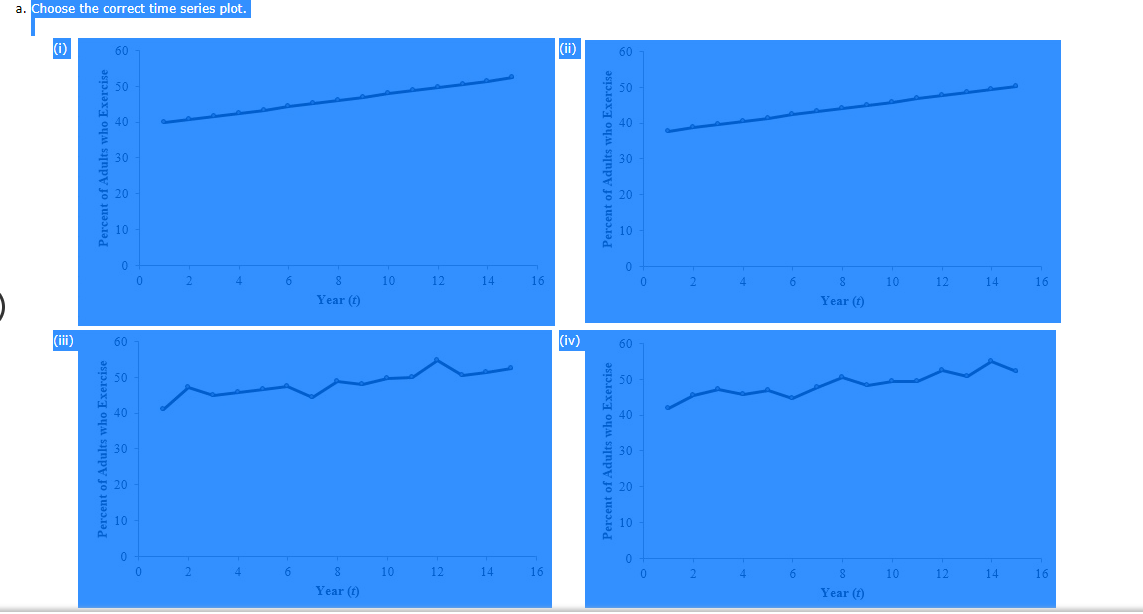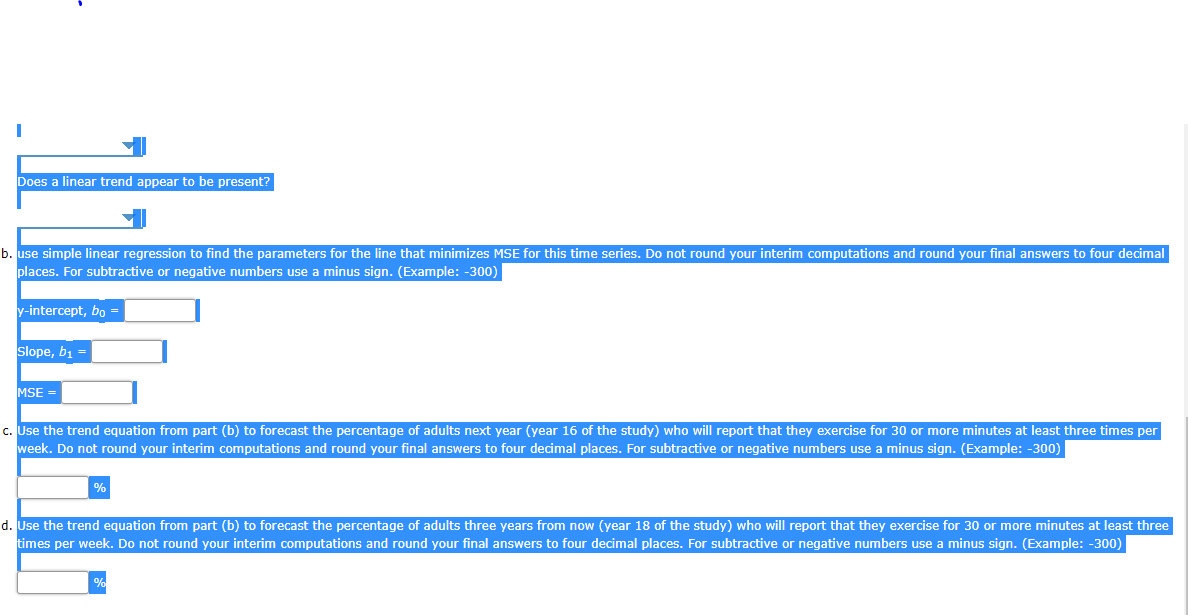Problem 6-23 (Algorithmic) The medical community unanimously agrees on the health benefits of regular exercise, but are adults listening? During each of the past 15 years, a polling organization has surveyed americans about their exercise habits. In the most recent of these polls, slightly over half of all American adults reported that they exercise for 30 or more minutes at least three times per week. The following data show the percentages of adults who reported that they exercise for 30 or more minutes at least three times per week during each of the 15 years of this study. Year Percentage of Adults Who Exercise 30 or more minutes at least three times per week 1 41.8 2 45.4 3 47.2 4 45.7 5 46.8 6 44.8 7 47.8 8 50.5 9 48.3 10 49.3 11 49.5 12 52.5 13 50.7 14 55 15 52.3 Choose the correct time series plot. (i) (ii) (iii) (iv) Does a linear trend appear to be present? use simple linear regression to find the parameters for the line that minimizes MSE for this time series. Do not round your interim computations and round your final answers to four decimal places. For subtractive or negative numbers use a minus sign. (Example: -300) y-intercept, b0 = fill in the blank 3 Slope, b1 = fill in the blank 4 MSE = fill in the blank 5 Use the trend equation from part (b) to forecast the percentage of adults next year (year 16 of the study) who will report that they exercise for 30 or more minutes at least three times per week. Do not round your interim computations and round your final answers to four decimal places. For subtractive or negative numbers use a minus sign. (Example: -300) fill in the blank 6 %
Problem 6-23 (Algorithmic) The medical community unanimously agrees on the health benefits of regular exercise, but are adults listening? During each of the past 15 years, a polling organization has surveyed americans about their exercise habits. In the most recent of these polls, slightly over half of all American adults reported that they exercise for 30 or more minutes at least three times per week. The following data show the percentages of adults who reported that they exercise for 30 or more minutes at least three times per week during each of the 15 years of this study. Year Percentage of Adults Who Exercise 30 or more minutes at least three times per week 1 41.8 2 45.4 3 47.2 4 45.7 5 46.8 6 44.8 7 47.8 8 50.5 9 48.3 10 49.3 11 49.5 12 52.5 13 50.7 14 55 15 52.3 Choose the correct time series plot. (i) (ii) (iii) (iv) Does a linear trend appear to be present? use simple linear regression to find the parameters for the line that minimizes MSE for this time series. Do not round your interim computations and round your final answers to four decimal places. For subtractive or negative numbers use a minus sign. (Example: -300) y-intercept, b0 = fill in the blank 3 Slope, b1 = fill in the blank 4 MSE = fill in the blank 5 Use the trend equation from part (b) to forecast the percentage of adults next year (year 16 of the study) who will report that they exercise for 30 or more minutes at least three times per week. Do not round your interim computations and round your final answers to four decimal places. For subtractive or negative numbers use a minus sign. (Example: -300) fill in the blank 6 %
Chapter6: Exponential And Logarithmic Functions
Section6.1: Exponential Functions
Problem 68SE: An investment account with an annual interest rateof 7 was opened with an initial deposit of 4,000...
Related questions
Topic Video
Question
-
Problem 6-23 (Algorithmic)
The medical community unanimously agrees on the health benefits of regular exercise, but are adults listening? During each of the past 15 years, a polling organization has surveyed americans about their exercise habits. In the most recent of these polls, slightly over half of all American adults reported that they exercise for 30 or more minutes at least three times per week. The following data show the percentages of adults who reported that they exercise for 30 or more minutes at least three times per week during each of the 15 years of this study.
Year Percentage of Adults Who Exercise 30 or more minutes at least three times per week 1 41.8 2 45.4 3 47.2 4 45.7 5 46.8 6 44.8 7 47.8 8 50.5 9 48.3 10 49.3 11 49.5 12 52.5 13 50.7 14 55 15 52.3 - Choose the correct time series plot.
(i) (ii) (iii) (iv)
Does a linear trend appear to be present?
- use simple linear regression to find the parameters for the line that minimizes MSE for this time series. Do not round your interim computations and round your final answers to four decimal places. For subtractive or negative numbers use a minus sign. (Example: -300)
y-intercept, b0 = fill in the blank 3
Slope, b1 = fill in the blank 4
MSE = fill in the blank 5 - Use the trend equation from part (b) to forecast the percentage of adults next year (year 16 of the study) who will report that they exercise for 30 or more minutes at least three times per week. Do not round your interim computations and round your final answers to four decimal places. For subtractive or negative numbers use a minus sign. (Example: -300)
fill in the blank 6 % - Use the trend equation from part (b) to forecast the percentage of adults three years from now (year 18 of the study) who will report that they exercise for 30 or more minutes at least three times per week. Do not round your interim computations and round your final answers to four decimal places. For subtractive or negative numbers use a minus sign. (Example: -300)
fill in the blank 7 %
- Choose the correct time series plot.

Transcribed Image Text:correct time series plot
12
14
8
Year (t)
(iv)
12
14 16
Percent of Adults who Exercise
Percent of Adults who Exercise
Percent of Adults who Exercise
Percent of Adults who Exercise
12

Transcribed Image Text:Does a linear trend appear to be present?
b. use simple linear regression to find the parameters for the line that minimizes MSE for this time series. Do not round your interim computations and round your final answers to four decimal
places. For subtractive or negative numbers use a minus sign. (Example: -300)
y-intercept, bo =
Slope, b, =
MSE
c. Use the trend equation from part (b) to forecast the percentage of adults next year (year 16 of the study) who will report that they exercise for 30 or more minutes at least three times per
week. Do not round your interim computations and round your final answers to four decimal places. For subtractive or negative numbers use a minus sign. (Example: -300)
%
d. Use the trend equation from part (b) to forecast the percentage of adults three years from now (year 18 of the study) who will report that they exercise for 30 or more minutes at least three
times per week. Do not round your interim computations and round your final answers to four decimal places. For subtractive or negative numbers use a minus sign. (Example: -300)
Expert Solution
This question has been solved!
Explore an expertly crafted, step-by-step solution for a thorough understanding of key concepts.
This is a popular solution!
Trending now
This is a popular solution!
Step by step
Solved in 5 steps with 3 images

Knowledge Booster
Learn more about
Need a deep-dive on the concept behind this application? Look no further. Learn more about this topic, statistics and related others by exploring similar questions and additional content below.Recommended textbooks for you


College Algebra
Algebra
ISBN:
9781305115545
Author:
James Stewart, Lothar Redlin, Saleem Watson
Publisher:
Cengage Learning

Algebra & Trigonometry with Analytic Geometry
Algebra
ISBN:
9781133382119
Author:
Swokowski
Publisher:
Cengage


College Algebra
Algebra
ISBN:
9781305115545
Author:
James Stewart, Lothar Redlin, Saleem Watson
Publisher:
Cengage Learning

Algebra & Trigonometry with Analytic Geometry
Algebra
ISBN:
9781133382119
Author:
Swokowski
Publisher:
Cengage